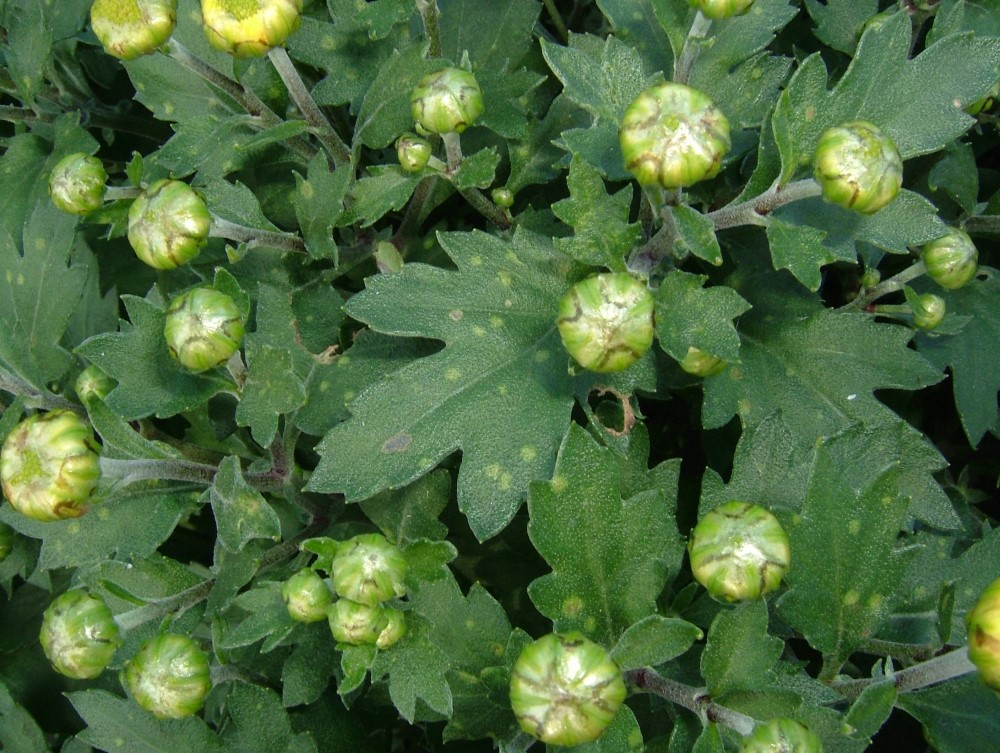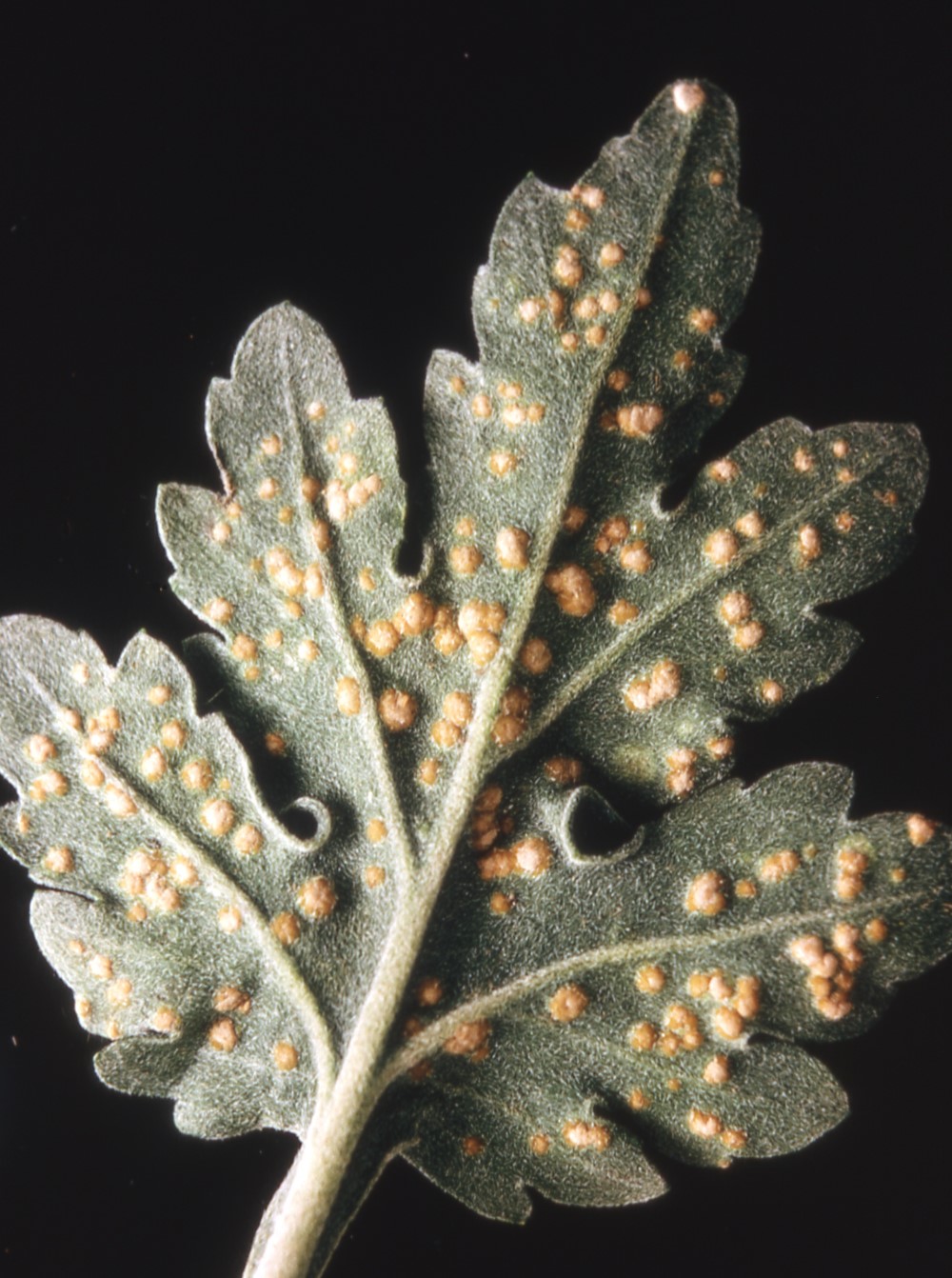Please click here to access the main AHDB website and other sectors.
- Home
- Knowledge library
- Cultural and chemical control strategies for rust diseases on protected ornamentals
Cultural and chemical control strategies for rust diseases on protected ornamentals
A combination of cultural and fungicide control measures will provide the best strategy for managing rusts on bedding and pot plants.
Back to: Control of rust diseases on protected ornamentals
Cultural control
Careful management of environmental conditions is key to avoiding serious rust outbreaks in any crop. If this is coupled with the following cultural control methods, the need for fungicides will be reduced:
- Remove all plant debris from previous crops and clean the glasshouse structure and benches thoroughly with disinfectant before the arrival of new plant material
- Control weeds around the nursery. Willowherbs (Epilobium and Chaemaenerion species) can act as infection reservoirs for fuchsia rust. Composite weeds, such as groundsel, may also be reservoirs for some rusts affecting bellis or cineraria. Bellis rust affects wild daisies
- Inspect plants and cuttings on arrival for symptoms of rust diseases. If symptoms are found, reject the consignment or isolate the plants while treatment is undertaken. Continue to monitor apparently disease-free plants, as they may arrive with symptomless (latent) infection
- If propagating from your own stock, regularly monitor the mother plants for rust infections. Never propagate from rust-affected material
- If possible, avoid plant species and varieties that are susceptible to rust pathogens
- Leaf wetness is key to infection, and prolonged periods of high relative humidity should be avoided. Reduce humidity by ventilation (with heat as appropriate) or use of fans and ensure adequate spacing between plants to increase air movement within the crop canopy
- Use in-crop environment monitoring equipment to alert you when dew point has been reached, and condensation may form on leaves, such as when warm, humid air encounters cold leaves
- Avoid overhead irrigation, particularly in the evening to avoid wet foliage overnight. Consider sub-irrigation where practical. Check the growing structure for leaks or areas where condensation drips onto plants and address
- Dispose of severely affected plants, bagging plants in-situ to avoid spreading spores around the glasshouse. Undertake a thorough clean-up after cropping, disposing of all plant debris
Chemical control
Fungicides will provide effective control against rust diseases applied at the appropriate time in combination with cultural control measures.
The table below lists the fungicides with activity against rusts, and are permitted for use on protected ornamentals (as of March 2021).
Fungicides with activity against rust diseases permitted on protected bedding and pot plants either by on-label or by Extension of Authorisation for Minor Use (EAMU), together with their mode of action classification by their Fungicide Resistance Action Committee (FRAC) group
|
Product |
Active ingredient |
FRAC group |
Approval status |
|
Amistar |
Azoxystrobin |
11 |
EAMU 3388/18 |
|
Karamate Dry Flo Neotec1 |
Mancozeb |
M3 |
On-label |
|
Nativo 75WG |
Tebuconazole + trifloxystrobin |
3 + 11 |
EAMU 2513/19 |
|
Systhane 20EW2 |
Myclobutanil |
3 |
EAMU 2026/20 |
1 The withdrawal of mancozeb has been confirmed by the EU, however a withdrawal notice has not yet been issued by the Chemicals Regulation Division (CRD) confirming grace periods for sale and use in the UK.
2 The active ingredient myclobutanil has not been supported for EU re-approval. Therefore myclobutanil is expected to be withdrawn across Europe when the approval expires on 31/05/2021. In GB, myclobutanil has automatically been granted a three year extension to its expiry date. If the active is also not supported in GB, then it may be withdrawn prior to the extended date of 31/05/2024.
Note. Not all of these products have been tested for phytotoxicity on bedding and pot plants. Application of products under EAMU approval is undertaken at the growers own risk. Plover (difenoconazole) also has activity against rusts but the EAMU (4256/19) only permits use on outdoor ornamental crops. When applied to control botrytis, Signum will also provide activity against rusts (EAMU 2141/12).
Please read the full disclaimer at the bottom of this page
Chrysanthemum white rust – yellow spots on the upper leaf surface

Image © AHDB
Chrysanthemum white rust – extensive pustules on the lower leaf surface

Image © ADAS Horticulture
Some products listed in the table have eradicant activity, including Systhane 20EW and, to a lesser extent, Amistar.
- Treatments should be applied as soon as disease symptoms occur to protect non-infected plant tissue from spore infection
- Sufficient spray volume should be applied to cover the upper and lower leaf surfaces, but without run-off, to ensure the plant receives the correct dose rate
- Consider extending spray intervals to reduce the number of fungicide applications. Research has shown protection from rust inoculation was maintained with a spray interval of 18 days
- Where the rust pathogen has become established, a single fungicide application is unlikely to provide adequate control
- Systhane 20EW can be used as both a protectant and eradicant against bellis and fuchsia rusts
- Amistar works well as a protectant treatment against bellis, fuchsia and pelargonium rusts, with some eradicant activity
- Systhane 20EW, followed seven days later by Amistar, can be a useful eradicant programme
Fungicide resistance management
Many fungicides with activity against rusts have been withdrawn in recent years, putting pressure on the few remaining actives. All efforts must be made to avoid fungicide resistance developing with the remaining products.
To reduce the risk of fungicide resistance developing:
- Use cultural control measures to minimise the risk of disease outbreaks and only use fungicides when needed
- Apply treatments at the recommended dose rate
- Apply fungicides as part of a resistance management programme. Where possible, apply fungicides with activity against rusts from at least two different Fungicide Resistance Action Committee (FRAC) mode of action groups (for control of rusts, there are currently limited opportunities to alternate products from different FRAC groups)
Resistance to myclobutanil (Systhane 20EW) and azoxystrobin (Amistar) has been reported in some isolates of chrysanthemum white rust (P. horiana) highlighting the potential risk for fungicide resistance to develop if fungicides are not used diligently.
Where there is resistance to one fungicide in a particular fungicide group, it is usual that there is also resistance to other fungicides within the same group. However, some rust pathogen strains may show multiple fungicide resistance, and products in completely different fungicide groups become ineffective, for example, Amistar (Group 11) and Systhane 20EW (Group 3) against chrysanthemum white rust.
Further advice on strategies to minimise the risk of selecting fungicide resistant strains of rust can be found at the Fungicide Resistance Action Committee (FRAC) website.
Crop safety
Different species and varieties of ornamental plants differ in their susceptibility to crop damage from fungicides, and small batches should be tested before wide-scale use of products new to the nursery.
The number of applications, weather conditions at the time of application and the ‘softness’ of plant growth may all influence crop damage. Examples of crop damage include:
- Amistar has been shown to scorch antirrhinum leaves when applied in hot, sunny conditions, but not when applied on cooler, cloudy days
- Some triazole products, including Systhane 20EW, can cause slight plant stunting, leaf distortion and thickening of young leaves on fuchsia
Application of products under EAMU authorisation is at the grower’s own risk.
Useful links
Crop Walkers’ Guide: Bedding & Pot Plants
Disclaimer
This table has been collated using information from the Health and Safety Executive (HSE) website (pesticides.gov.uk) and from product labels and supplier technical leaflets. Important – regular changes occur in the approval status of plant protection products, arising from changes in the legislation or for other reasons. For the most up-to-date information, please check the HSE website or with a professional supplier or BASIS-qualified consultant, as information could have changed since the publication of this factsheet.
EAMU – Extension of authorisation for minor use.
LTAEU – Long term arrangements for extension of use.
Growers must hold a paper or electronic copy of an EAMU before using any product under the EAMU arrangements. Any use of a plant protection product via an EAMU is at the grower’s own risk.
Always follow approved label or EAMU recommendations, including rate of use, maximum number of applications per crop or year, and where crop safety information is not available, test the product on a small number of plants to determine crop safety prior to widespread commercial use.
If in doubt about which products are permissible on ornamentals or how to use them correctly, seek advice from a BASIS-qualified consultant with expertise in ornamental plant production.
Webpage content correct as of March 2021.
Author(s) – Dave Kaye and Erika Wedgwood, ADAS Horticulture.
Original author(s) – Tim O’Neill and John Scrace, ADAS Horticulture.

